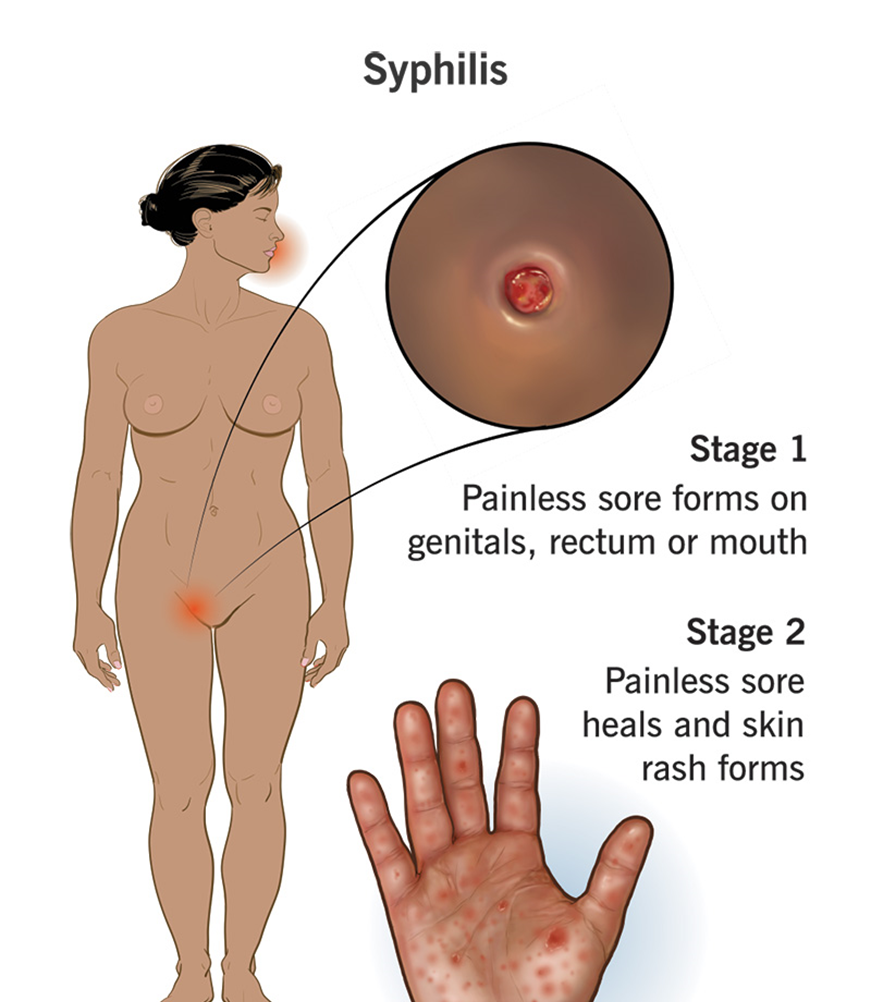Which of the following is a bacterial infection that spreads through any form of unprotected sex and by skin contact? Typically, it has stages of increasingly serious symptoms. If untreated, it may affect the heart, eyes, and brain. It can be treated with antibiotics.
Gonorrhea
Syphilis
Chlamydia
Trichomoniasis
The Correct Answer is B
Choice A reason: Gonorrhea is incorrect because it is not the infection described in the question. It is a bacterial infection that spreads through any form of unprotected sex, but it does not have stages of symptoms or affect the heart, eyes, and brain. It can cause pain, discharge, and inflammation in the genitals, anus, or throat. It can be treated with antibiotics.
Choice B reason: Syphilis is correct because it is the infection described in the question. It is a bacterial infection that spreads through any form of unprotected sex and by skin contact. It has stages of symptoms, such as sores, rashes, fever, and fatigue. If untreated, it can affect the heart, eyes, and brain, causing serious complications. It can be treated with antibiotics.
Choice C reason: Chlamydia is incorrect because it is not the infection described in the question. It is a bacterial infection that spreads through any form of unprotected sex, but it does not have stages of symptoms or affect the heart, eyes, and brain. It often causes no symptoms, but it can cause pain, discharge, and bleeding in the genitals or rectum. It can be treated with antibiotics.
Choice D reason: Trichomoniasis is incorrect because it is not the infection described in the question. It is a parasitic infection that spreads through any form of unprotected sex, but it does not have stages of symptoms or affect the heart, eyes, and brain. It can cause itching, burning, and odor in the genitals. It can be treated with antiparasitic drugs.

Nursing Test Bank
Naxlex Comprehensive Predictor Exams
Related Questions
Correct Answer is A
Explanation
Choice A reason: Strategies to enhance condom use is correct because it is the most effective way to motivate clients to use condoms consistently and correctly. Some of these strategies include providing education, demonstrating skills, addressing barriers, and promoting communication.
Choice B reason: Places to carry condoms safely is incorrect because it is not the most essential component of counseling related to the prevention of sexually transmitted infections and human immunodeficiency virus. It is a practical aspect of condom use, but it does not address the underlying attitudes, beliefs, and behaviors that influence condom use.
Choice C reason: Leaving the decision up to the male partner is incorrect because it is not a way to motivate clients to use condoms. It is a passive and disempowering approach that can increase the risk of infection and unwanted pregnancy. Clients should be encouraged to take an active role in their sexual health and negotiate condom use with their partners.
Choice D reason: Choice of colors and special features is incorrect because it is not the most essential component of counseling related to the prevention of sexually transmitted infections and human immunodeficiency virus. It is a superficial aspect of condom use, but it does not address the underlying attitudes, beliefs, and behaviors that influence condom use.
Correct Answer is D
Explanation
Choice A reason: Congenital anomalies of the central nervous system are not a common complication of GDM, as they usually occur in the first trimester, before GDM develops. However, GDM can increase the risk of other congenital anomalies, such as cardiac defects or neural tube defects.
Choice B reason: Preterm birth is a possible complication of GDM, as it can be caused by maternal hypertension, preeclampsia, or placental abruption. However, it is not the most likely complication, as GDM can also delay the onset of labor and prolong the pregnancy.
Choice C reason: Low birth weight is not a typical complication of GDM, as it is more associated with intrauterine growth restriction (IUGR), which is caused by placental insufficiency. GDM can cause the opposite problem, which is excessive fetal growth.
Choice D reason: Macrosomia is the most common complication of GDM, as it is defined as a birth weight of more than 4,000 grams (8.8 pounds). It is caused by the excess glucose crossing the placenta and stimulating the fetal insulin production, which leads to increased fat deposition and organ enlargement. Macrosomia can increase the risk of birth trauma, shoulder dystocia, and neonatal hypoglycemia.
Whether you are a student looking to ace your exams or a practicing nurse seeking to enhance your expertise , our nursing education contents will empower you with the confidence and competence to make a difference in the lives of patients and become a respected leader in the healthcare field.
Visit Naxlex, invest in your future and unlock endless possibilities with our unparalleled nursing education contents today
Report Wrong Answer on the Current Question
Do you disagree with the answer? If yes, what is your expected answer? Explain.
Kindly be descriptive with the issue you are facing.
